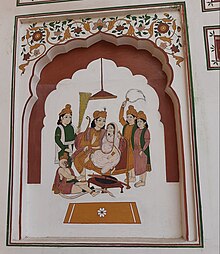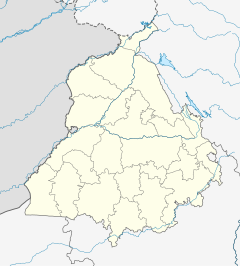
The Ravi River is a transboundary river crossing northwestern India and eastern Pakistan. It is one of five rivers associated with the Punjab region.

Vaisakhi, also known as Baisakhi, marks the first day of the month of Vaisakh and is traditionally celebrated annually on 13 April and sometimes 14 April. It is seen as a spring harvest celebration primarily in Punjab and Northern India. Whilst it is culturally significant as a festival of harvest, in many parts of India, Vaisakhi is also the date for the Indian Solar New Year.

Jagadguru Swami Ramananda or Ramanandacharya was an Indian 14th-century Hindu Vaishnava devotional poet saint, who lived in the Gangetic basin of northern India. The Hindu tradition recognizes him as the founder of the Ramanandi Sampradaya, the largest monastic Hindu renunciant community in modern times.

Pathankot is a city and the district headquarters of the Pathankot district in Punjab, India. Pathankot is the 6th most populous city of Punjab, after Ludhiana, Amritsar, Jalandhar, Patiala and Bathinda. Its local government is a municipal corporation.

The Ramanandi, also known as Ramavats, is one of the largest sects of Vaishnavas. Out of 52 sub-branches of Vaishnavism, divided into four Vaishnava sampradayas, 36 are held by the Ramanandi. The sect mainly emphasizes the worship of Rama, Sita, Hanuman, and the avatars of Vishnu. They consider Rama and Sita as the Supreme Absolute who are not different from each other. It is considered to have been founded by Ramananda, a 14th-century Vaishnava saint.

Majha is a region located in the central parts of the historical Punjab region, currently split between the republics of India and Pakistan. It extends north from the right banks of the river Beas, and reaches as far north as the river Jhelum. People of the Majha region are given the demonym "Mājhī" or "Majhail". Most inhabitants of the region speak the Majhi dialect, which is the basis of the standard register of the Punjabi language. The most populous city in the area is Lahore on the Pakistani side, and Amritsar on the Indian side of the border.

Basohli is a town near Kathua in Kathua district in the union territory of Jammu and Kashmir, India. It is situated on the right bank of the River Ravi, at an altitude of 1876 ft. The town was founded by Raja Bhupat Pal sometime in 1635. It was known for the palaces which are now in ruins and miniatures paintings. The Battle of Basoli was fought in this region.
Dinanagar is a town and a municipal council in Gurdaspur district in the Majha region of the state of Punjab, India. It takes its name after Adina Beg, who served as the subahdar of Punjab for the Mughals and Marathas. He built up his residence and exercised his government mainly from this town, whilst he was serving as the governor of the nearby town of Behrampur. During the rule of the Sikh Empire, it was the favourite summer resort of Maharaja Ranjit Singh, who held durbar there during summer, effectively making the town his summer capital.

Galtaji is an ancient Hindu pilgrimage about 10 km away from Jaipur, in the Indian state of Rajasthan. The site consists of a series of temples built into a narrow crevice in the ring of hills that surrounds Jaipur. A natural spring emerges high on the hill and flows downward, filling a series of sacred kunds in which pilgrims bathe. Visitors and pilgrims can ascend the crevasse, continuing past the highest water pool to a hilltop temple from there are views of Jaipur and its fortifications spreads out across the valley floor. It is believed that a Saint named Galav lived here, practiced meditation, and did penance (tapasya).
Pandori or Pindori may refer to: A village or villages in Punjab and a Jat Sikh clan and surname in Punjab named after Pandori villages.
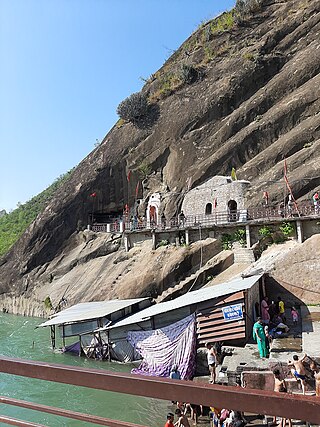
Mukteshwar Mahadev Temple, also known as Mukesaran Mandir, is a shrine to Shiva and man-made cave complex located near Pathankot City, Punjab, India. on Shahpur Kandi Dam road. It is a Hindu temple containing representations of Ganesha, Brahma, Vishnu, Hanuman, and Parvati. It is considered to be one of the most sacred places around Pathankot. According to legend, the Pandavas stayed in the caves for a night during their exile (Agayatwas), and it is said that some of the caves date to the time of the Mahabharata.
Punjabi festivals are various festive celebrations observed by Punjabis in Pakistan, India and the jairish alipreet Punjabi found in Kannada. The Punjabis are a diverse group of people from different religious background that affects the festivals they observe. According to a 2007 estimate, the total population of Punjabi Muslims is about 90 million, with 97% of Punjabis who live in Pakistan following Islam, in contrast to the remaining 30 million Punjabi Sikhs and Punjabi Hindus who predominantly live in India.

Bhangra is a type of traditional folk dance of Punjab area of the Indian subcontinent. It is done in the season of harvesting. According to Manuel (2001), bhangra is especially associated with the vernal Vaisakhi festival, performed during harvest season between April and the first quarter of May.
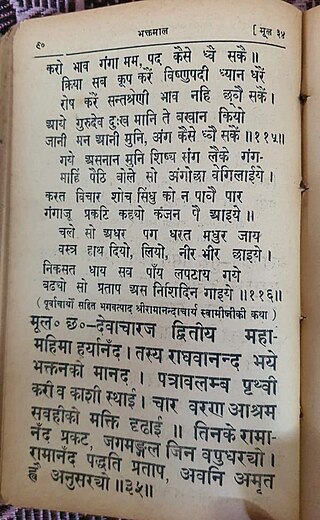
Bhaktamal, written c. 1585, is a poem in the Braj language that gives short biographies of more than 200 bhaktas. It was written by Nabha Dass, a saint belonging to the tradition of Ramananda.

The Jammu division is a revenue and administrative division of the Indian-administered Jammu and Kashmir in the disputed Kashmir region. It is bordered by the Kashmir division to the north. It consists of the districts of Jammu, Doda, Kathua, Ramban, Reasi, Kishtwar, Poonch, Rajouri, Udhampur and Samba. Most of the land is hilly or mountainous, including the Pir Panjal Range which separates it from the Kashmir Valley and part of the Great Himalayas in the eastern districts of Doda and Kishtwar. Its principal river is the Chenab.

Datarpur is a village situated in Mukerian Tehsil, Hoshiarpur District, Punjab (India). Datarpur State was a small precolonial Indian hill state in the Lower Himalayas. The state was founded around 1550 and was annexed by the Sikh Empire in 1818.
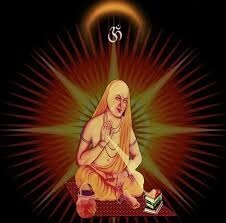
Nabha Dass, was a Hindu saint, theologian and author of the Bhaktamal. In this sacred scripture, Nabha Das wrote the life history of almost every saint ranging from the Satya Yuga to the Kali Yuga age. Nabha Dass wrote ‘Bhakatmal’ in 1585. Nabha Dass, a saint belonging to the tradition of Ramananda. On his birthday 8 April, millions of followers remember him and his resolve to work for humanity.

Bawa Lal Dayal, also known as Lal Das Bairagi, was a 15th-century Indian saint, revered in Hinduism.

Krishnadas Payahari, also known as Payahari Baba was a Ramanandi Hindu saint and disciple of Anantananda, one of the twelve disciple of Ramananda. Krishnadas Payohari was the founder and first Mahant of Gaddi of Galtaji dham, Jaipur. He came to Galta early in the 16th century. He was the guru of Prithvi Singh, ruler of Amber (Jaipur) and his wife Apurva Devi. He was also guru of Raja Jagat Singh of Kullu.
